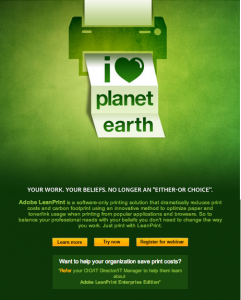
“Print if you must… but do it with love.” These words were the subject of an email I received from Adobe Systems Incorporated. In it they advertised a new product known as Adobe LeanPrint, a sustainable solution to those with excessive printing needs.
How Adobe LeanPrint works is that it converts document layouts made on frequently used programs, like Microsoft Word, to a more optimal design, maximizing the amount of space on the page to reduce the number of pages in any document. The software also converts colour documents to equally presentable/pleasing black and white prints that enable users to manage their toner costs more efficiently. Adobe LeanPrint is positioned as a product intended to reduce energy consumption, save printing costs, and present businesses with a more sustainable option to their printing needs.

It boasts the ability to reduce costs by 50%, if implemented throughout the entire organization, and specifies that “[using their product] is good for you, and for the planet.”
Adobe should be praised for their innovative thinking, especially when curbing print and energy consumption is presumably a considerable issue for their business. As a creative software design company, most of their products probably require a printer to be of use to their customers. For being environmentally conscious and socially responsible of their carbon footprint, Adobe is another company that’s once again starting up the conversation on sustainability in printing/technology.
However, as they have made it clear that this product will reduce costs based on a company’s regular consumption habits, what happens when a company takes advantage of this sudden reduction of cost, like the elimination of a bottleneck in logistics, and decides to maximize on the new number of possible pages to print. Would Adobe then be helping to ‘save the planet’ or would they just be helping a company take advantage of a cost savings tool?
It’s a fair question, I think, but on further thought, here’s how I see it. I’m assuming that Adobe’s first intention in designing this product was to help companies with their printing costs – let’s create a more efficient product for our customers, so to speak. However, when it came to marketing the product, they realized the value in positioning the product as a ‘sustainable’ and an ‘environmentally-friendly’ solution – a tactic that would elevate their status as a socially responsible company and bring their products and services into the evoked set of socially conscious consumers. No matter what the case, whether this product will convince users to ‘save the planet’ or whether it should really be marketed with the words ‘save money’ instead, a massive software company taking a socially responsible stance on sustainability is a good sign.